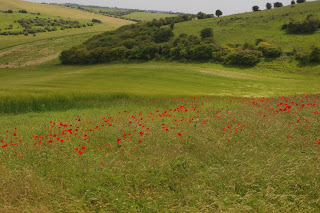A diary of back garden botany, urban ecology, rural rambles and field trips to the middle of nowhere...
Monday, 15 July 2019
I'm off to the States today for my now traditional annual vacation in the USA. As in previous years I'll spend a few days catching up with friends in San Francisco then do some trekking in the backcountry.
In 2016 I hiked on Mount Shasta in northern California, then in 2017 around Crater Lake in southern Oregon, last year it was back to NorCal to explore Mount Eddy. This time round I'm heading eastwards to Lake Tahoe on the California/Nevada border.
So there won't be entries while I'm away, but I'll start posting again early August.
Sunday, 14 July 2019
The combination of Runner Beans and Nasturtiums seems to be working well on the allotment. The Runners are climbing and flowering nicely and the Nasturtiums make a useful (and colourful) groundcover and living mulch.
Apparently Runner Beans were introduced to this country in Elizabethan times as an ornamental though they're now regarded as a crop. Similarly Nasturtiums are generally grown for their attractive flowers but the leaves, buds and flowers are edible.
Friday, 12 July 2019
A patch of Great Willowherb (Epilobium hirsutum) has self-seeded in the garden. As it happens I'd been wondering what tall, late summer flowering perennial would look good there so the decision has been made for me! Seek and ye shall find?
In fact with that in mind I had already planted several pots of the white flowered form of Rosebay Willowherb (Chamanerion angustifolium 'Album') which seems to be establishing itself. Willowherbs can be invasive but the combination of the two growing through each other should be pleasing.
'Album' is said to be less vigorous (and is rarer) than the very widespread rose-pink form of C. angustifolium which is a common site at this time of year. The drifts of colour can often be spotted along railway lines and roadsides; too rampant to be a garden plant but very attractive...
Thursday, 11 July 2019
I let the garden run wild as we go deeper into summer. The masses of pink flowers on the clumps of Geranium x oxonianum are especially prolific and long lasting this year. Honey bees are very much in evidence (there are a number of hives in the neighbourhood).
Despite some rain a couple of weeks ago the garden is very dry, particularly at the back under the canopy of the large Sycamore.
Wednesday, 10 July 2019
The Corn Poppy aka the Common Poppy (Papaver rhoeas) has proved to be the most resilient of the cornfield annuals I listed in my previous entry. I saw the ones above while walking on the South Downs a few weeks ago. Like all such 'arable weeds' poppies were sprayed into near oblivion but the flowers produce a huge number of dust-like seeds (tens of thousands per plant!) and these can remain viable in the soil for decades.
About ten years ago a new railway embankment was commissioned between Hitchin and Letchworth in Hertfordshire where the mainline splits between the north and East Anglia. It was built up by scalping the chalky soil from the surrounding fields. The following year it became a blazing ribbon of crimson; I imagine it was probably visible from outer space so intense was the colour. Papaver rhoeas can generate a substantial seed bank over time and clearly a great quantity of dormant seed was stirred up by the works.
The fields of Flanders were covered in these poppies in the aftermath of the bombardments of the First World War. Throughout history the regenerative powers of the red poppy have been a potent symbol.
Tuesday, 9 July 2019
Cornfield annuals would once have been among the most common of common wildflowers. Corn Chamomile, Corn Marigold, Corn Poppy, Cornflower and Corncockle (above) were some of the most prolific of the self-seeding 'arable weeds'. Herbicides largely exterminated them but they can still be found on the margins of modern agriculture and they have enjoyed something of a revival as a deliberately cultivated wildflower.
Monday, 8 July 2019
Continuing the subject of Mulleins from the last entry. This is Dark Mullein (Verbascum nigrum). I saw quite a few of these on Saturday following a track to the top of Box Hill in Surrey. They were flourishing in the scrubby margins between the track and the woods that cover the hill.
They look distinctively different to V. thapsus which are often called the Common or Great Mullein. Verbascums are plants of the Scrophulariacae family which also includes the various species of Digitalis. The Dark Mullein in particular has something of the Foxglove about it.
Saturday, 6 July 2019
I mentioned these Mulleins in an entry last month [In praise of neglected areas, 11th. June]. At that point the first flowers were forming and I identified them as Verbascum thapsus which I think is correct. Generally V. thapsus throws up a single flower spike but occasionally produces multiple side spikes as is the case here. Then again Verbascum bombyciferum is sometimes grown in gardens and is characterised by the 'candelabra' effect but the leaves are more silvery and silkier than the ones here so I'm inclined to stick with V. thapsus. I'll have a closer look next time I'm passing.
Tuesday, 2 July 2019
Brambles (Rubus fruiticosus) are in flower the length and breadth of the land. They can tough it out almost anywhere and are hard to eradicate forming dense thickets if left to their own devices. For that reason they provide useful protection for wildlife and a big hit of nectar and pollen for the bees- meaning blackberries in abundance later in the season.
Subscribe to:
Comments (Atom)



























